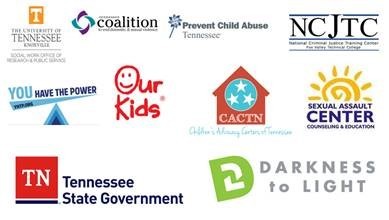Tennessee Child Sexual Abuse Prevention Committee

Origin
Formed in May 2019, agencies currently involved in child sexual abuse prevention efforts were brought together to discuss the need for collaboration and a statewide plan. All participating agencies agreed on the need to break down silos and combine forces to increase child sexual abuse prevention efforts in Tennessee.
Mission
Promote child safety to prevent child sex abuse in Tennessee through quality training, education and awareness, evidence-based programs, and strong partnerships with local communities.
Values
- All children & youth (under 18 years of age) deserve to be safe and free of abuse.
- Adults must bear the responsibility to try to protect all minors from sexual abuse.
- Communities and child serving agencies must provide the education and tools to protect the children and teens in their environments.
- Children and students should be educated and empowered to have their bodies respected and unharmed.
- Investigative agencies should be provided with training that supports the quality of their case work and work with families.
Subcommittee Structure
- Prevention Training Team
- Child Protective Investigative Team Education Team
- Community Awareness Team
- Data & Analysis Team
Involved Agencies
- Department of Children’s Services
- Our Kids
- Prevent Child Abuse Tennessee
- Sexual Assault Center
- You have the Power
- Davis House
- Carl Perkins Center
- Memphis Children’s Advocacy Center
- Meharry Medical College
- AWAKE
- National Criminal Justice Training Center
- University of Tennessee SWORPS
- Nashville Children’s Alliance
- Children’s Advocacy Centers of Tennessee
- Children's Advocacy Center of Hamilton County
- Kid’s First
- TN Coalition to End Domestic & Sexual Violence
- Children's Advocacy Center of the Cumberlands
- U.S. Department of Justice
- Office of Criminal Justice Programs
Common Definitions
Child Sexual Abuse- 1. Child sexual abuse occurs when a child who is under the age of 13 or was under the age of 13 when the abuse occurred or a child is age 13-18 and meets the relationship criteria per policy, and the child is involved in intentional sexual acts that produce sexual arousal and/or gratification for the perpetrator including: a) Explicit sexual acts; b) Vaginal, oral, anal or digital penetration with or without the use of an object; c) Touching, fondling, molestation or intentional contact with genitals, buttocks or breasts of child or perpetrator. This also includes when adolescents or adults instruct children to engage in such behaviors with each other; d) Indecent exposure and voyeurism; and e) Intentionally exposing a child to sexually explicit material. 2. Sexual behaviors or situations in which the motivation may or may not be sexual, but there is a clear sexual component such as: a) Taking pictures or videos of children engaging in sexual activities or in sexually explicit poses; b) Making children available to others for sexual purposes; c) The sexual gratification or benefit of an adult; d) Use of a child for prostitution; and e) Caregiver has knowledge or reasonable suspicion of child sexual abuse by another person and intentionally fails to intervene or protect child. 3. The use of any person under the age of eighteen (18) as defined in, numbers one (1) and two (2) of this section in exchange for anything of value either directly or indirectly. Force, threat or coercion is not a factor for Commercial Sexual Exploitation of a Minor. (TN Department of Children’s Services, Work Aid 1)
Primary Prevention- Primary prevention consists of activities that are targeted toward the community at large. These activities are meant to impact families before any allegations of abuse and neglect. Primary prevention services include public education activities, parent education classes that are open to anyone in the community, and family support programs. Primary prevention can be challenging to measure because you are attempting to impact something before it happens, an unknown variable. This type of activity is a focus of CBCAP programs. (Children's Bureau)
Secondary Prevention- Secondary prevention consists of activities targeted to families that have one or more risk factors, including families with substance abuse, teen parents, parents of special needs children, single parents, and low-income families. Secondary prevention services include parent education classes targeted for high-risk parents, respite care for parents of a child with a disability, or home visiting programs for new parents. (Children's Bureau)
Tertiary Prevention- Tertiary prevention consists of activities targeted at families that have confirmed or unconfirmed child abuse and neglect reports. These families have already demonstrated the need for intervention, either with or without court supervision. These are families that qualify for services under child welfare programs and are not a focus of CBCAP programs. (Children's Bureau)